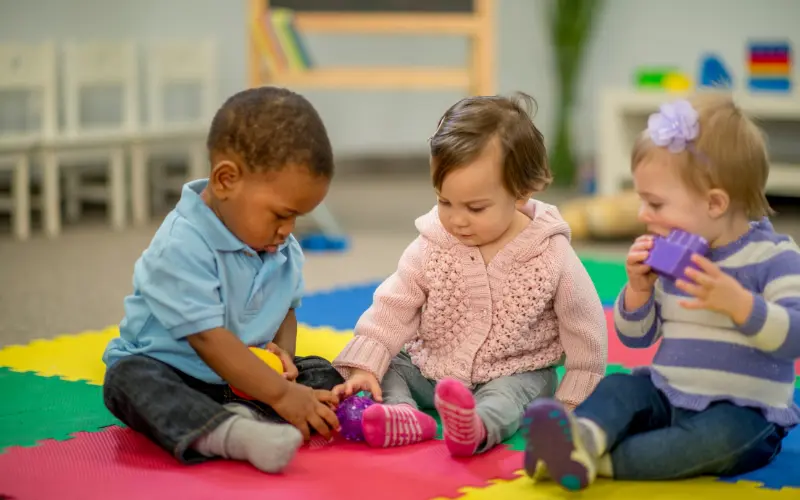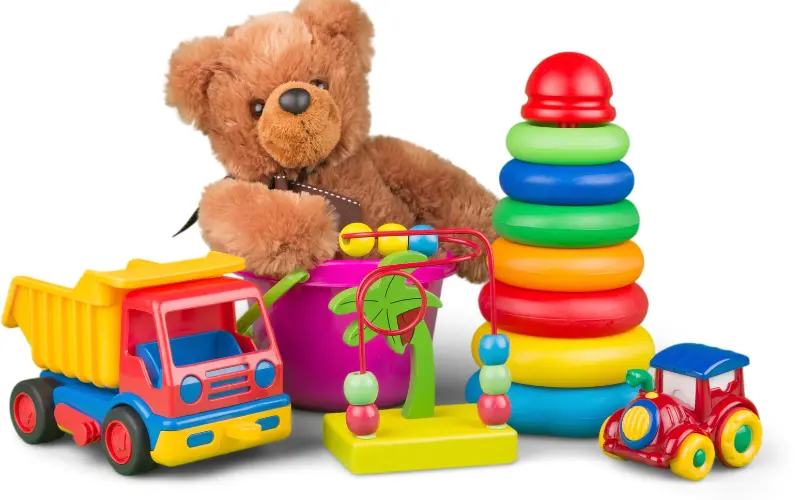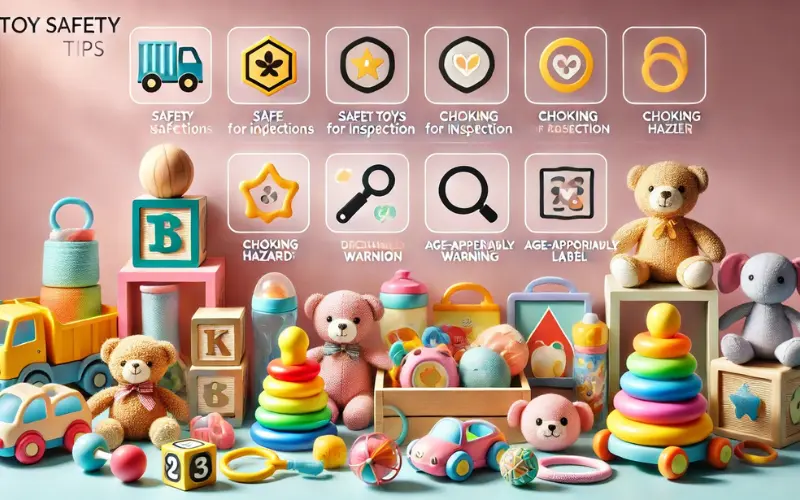Table of Contents
Toy Safety Tips Parents
As parents, ensuring our children’s safety is always a top priority, especially when it comes to toys. While toys are meant to entertain and aid in child development, they can pose safety risks if not chosen carefully. In this comprehensive guide, we will share valuable toy safety tips every parent should know to keep your little ones safe during playtime. We’ll also highlight a few must-have products from E Baby Mart, perfect for promoting safety and enjoyment for your child. Whether you’re purchasing a toy for a toddler or preschooler, following these safety tips will give you peace of mind. Let’s dive into the must-know safety measures for parents.
For parents, understanding the importance of choosing safe toys is paramount. The American Academy of Pediatrics provides comprehensive toy safety tips that can help ensure your child’s playtime is both enjoyable and safe. It’s essential to stay informed about the latest safety standards and recommendations to protect your little ones.
Choosing Safe Toys for Toddlers and Preschoolers

When it comes to choosing safe toys for toddlers and preschoolers, there are several important factors to consider. The right toy should not only engage your child and foster creativity but should also be free from potential hazards. Here are the key aspects every parent should keep in mind when selecting toys:
- Age appropriateness: Always check the toy’s packaging for the age recommendation. Toys designed for older children often contain small parts that can pose choking hazards for toddlers and preschoolers. Age guidelines are there for a reason, and selecting toys specifically designed for your child’s age group can minimize risk.
- Non-toxic materials: Young children, particularly toddlers, are known for putting toys in their mouths. Therefore, it’s essential to choose toys made from non-toxic materials. Look for products that are labeled as “BPA-free,” “lead-free,” or made from 100% organic materials.
- Durability and design: Toddlers and preschoolers can be rough with their toys, so it’s crucial to select durable toys that won’t break easily. Broken toys can present a choking hazard or cause cuts. Check for well-constructed toys with no sharp edges or detachable small parts.
If you’re looking for safe toy options, consider our Non-Toxic Building Blocks Set, which are designed with toddlers in mind. These blocks are large enough to prevent choking and are made from BPA-free materials, ensuring that your child’s safety comes first.
In addition to ensuring your toys are safe, it’s crucial to create a secure environment for your child. For comprehensive guidance on safeguarding every room in your home, check out our article, Babyproofing Your House: A Checklist for Every Room. This resource provides essential tips and strategies to help you minimize hazards and keep your little one safe as they explore their surroundings. From securing furniture to managing electrical outlets, taking these proactive measures will complement your efforts in toy safety.
Toy Safety Tips for Parents: What to Look Out For

Beyond selecting the right toy, there are several toy safety tips for parents that you should always follow when introducing new toys into your home. Being aware of potential hazards and taking precautions can significantly reduce the chances of accidents.
- Avoid small parts: Small detachable parts, such as buttons, beads, or removable eyes on stuffed animals, are a choking hazard for young children. Always check the toy’s construction and avoid those with small, loose parts.
- Sharp edges and points: Toys with sharp edges, points, or protruding parts can injure your child. Ensure that all toys, especially plastic ones, are smooth and free of sharp edges.
- Strings or cords: Toys with long strings or cords can pose a strangulation risk, particularly for younger children. If the toy comes with a string or cord, make sure it is short enough to not wrap around a child’s neck.
- Magnets and batteries: Avoid toys with magnets or unsecured batteries, as these can be extremely dangerous if swallowed. Always check that battery compartments are securely fastened with screws.
Our Baby-Safe Plush Toys are a perfect example of safe, durable, and age-appropriate toys for toddlers. These toys have no small parts, sharp edges, or long cords, offering complete peace of mind for parents.
Toy Safety Tips Every Parent Should Know: Ongoing Maintenance
While choosing the right toys is important, ongoing maintenance and careful monitoring of your child’s toys are just as crucial for safety. Here are some of the most essential toy safety tips every parent should know when it comes to maintaining and organizing toys:
- Regular inspections: Toys that are damaged or broken can pose a significant risk to your child. Inspect toys regularly to check for signs of wear and tear, such as cracks, broken pieces, or loose parts. If a toy is damaged beyond repair, it’s safer to discard it than risk your child getting injured.
- Cleaning toys frequently: Toys, especially those that are often placed in a child’s mouth, should be cleaned regularly to prevent the spread of germs and bacteria. Soft toys should be machine-washable, while hard toys can be cleaned with a mild soap and water solution.
- Proper storage: Storing toys properly is essential for preventing accidents. Toys that are left on the floor or scattered around can become tripping hazards for both children and adults. A proper toy storage system ensures that toys are easily accessible but safely out of the way when not in use.
Our Toy Storage Organizer is the perfect solution for keeping toys neatly stored and out of harm’s way. It teaches kids the importance of cleaning up after themselves while helping parents maintain a safe and organized environment.
Choosing Safe Toys for Toddlers and Preschoolers: Avoiding Common Risks

When choosing safe toys for toddlers and preschoolers, there are some additional risks to consider to ensure safety:
- Battery-operated toys: If you’re considering a battery-operated toy, make sure that the battery compartment is secure and cannot be easily accessed by a child. Batteries can be harmful if swallowed and may cause choking or internal injury.
- Noisy toys: Be cautious when selecting toys that make loud noises. Toys with high decibel levels can cause hearing damage, especially if your child holds the toy too close to their ear. Always test the noise level before giving a toy to your child.
- Toys with magnets: Avoid toys with small, powerful magnets, especially if they are loose or easily detached. Magnets can cause serious injury or even life-threatening complications if swallowed by your child.
Toy Safety Tips for Parents: Supervision and Safe Play Areas
An essential part of toy safety tips for parents involves supervising your child and creating a safe play environment. Supervision is key, especially for toddlers and preschoolers who may not yet understand the potential risks involved in playing with certain toys.
- Create a dedicated play space: Designate a specific area in your home for your child’s toys and playtime. This area should be free of potential hazards, such as stairs, sharp furniture, or electrical outlets. A safe play space helps reduce the risk of accidents.
- Supervise playtime: Young children, especially toddlers, should not be left unattended during playtime. Even toys that seem safe can become dangerous if misused. Always supervise your child and intervene if they are playing with a toy inappropriately.
- Encourage safe play habits: Teaching your child the importance of safe play from a young age can help prevent accidents. Encourage your child to play with toys gently, avoid throwing them, and put them away when playtime is over.
By following these toy safety tips every parent should know, you can create a safe play environment for your child and reduce the chances of accidents.
Toy Safety Tips Every Parent Should Know: Final Thoughts

In conclusion, ensuring your child’s safety during playtime starts with choosing safe toys for toddlers and preschoolers. Selecting age-appropriate, non-toxic, and durable toys is the first step in creating a safe play environment. However, toy safety doesn’t stop there—supervision and ongoing maintenance are equally important in preventing accidents.
Regularly inspect your child’s toys for damage, clean them frequently, and store them properly when not in use. Additionally, following toy safety tips for parents such as avoiding small parts, sharp edges, and toys with loose batteries or magnets can help keep your child safe during playtime.
Explore our store for more products that prioritize safety, such as the Non-Toxic Building Blocks Set, Baby-Safe Plush Toys, and Toy Storage Organizer. These products are designed with safety in mind to help create a safe and fun play environment for your child.
By keeping these toy safety tips every parent should know in mind, you’ll be well-equipped to provide your child with a safe and enjoyable playtime experience.

